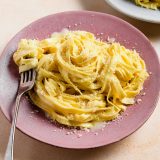Disdain, disbelief, dismissal. Brace for them all. It’s the cycle of responses that spill eagerly from Italians to questions about a dish Americans consider culinary canon. Fettuccine Alfredo? Tourist food. An American bastardization. Nobody eats it.
And they are right. The two Roman restaurants that tug-of-war over claims to serving the most authentic fettuccine Alfredo are hotspots for the bus tour masses, complete with walls plastered black-and-white with headshots of celebrities of yore.
A murky and romanticized origin story—at least in conventional telling—doesn’t help. Worse yet, American fettuccine Alfredo bears so little resemblance to the recipe in that backstory it’s almost unfair to call the dish Italian.
Except, they also are completely wrong.
Fettuccine Alfredo, it turns out, may well be one of the primordial Italian pastas. And it most certainly is eaten by everyday Italians. Here, there and everywhere. It’s also nothing like you think. Most importantly, it’s unbelievably delicious.
But learning this would require a 1,000-mile journey across Italy via planes, trains and Fiats, winding from Roman trattorias to the towering cheese caves of Parma, and ending in a medieval hilltop village seemingly lost to time.
Ristorante Alfredo alla Scrofa
Creamy and so rich, fettuccine Alfredo is ubiquitous to Italian-American menus. But something clearly was lost in translation. Larded with heavy cream, milk, garlic, flour and multiple varieties of cheese, most American Alfredo is a sodden, fatty mess. And don’t even talk about adding chicken, shrimp or mushrooms to the equation.
So let’s establish one thing at the outset. True fettuccine Alfredo contains just five ingredients: fresh egg fettuccine, butter, Parmigiano-Reggiano cheese, water and salt. Warmed by the just-cooked pasta, the butter and cheese should melt into a smooth, creamy marriage, a bond held tight by the starchy water in which the fettuccine was cooked.
Deceptively simple. So much so—as I would learn—it is shockingly easy to mess up.
Any exploration of fettuccine Alfredo must begin where its mythology was born. Ristorante Alfredo alla Scrofa sits a short walk from Rome’s too-often-too-packed Piazza Navona, tucked onto a cobblestone side street—Via della Scrofa—the name of the signature dish spelled out in lit green letters that tower up the face of the building.
The story begins in 1908, not long after Alfredo di Lelio opened this restaurant. As lore tells it, his wife was weak from childbirth. To restore her strength, he reached for a recipe recorded as early as the 15th century, called simply “Roman macaroni.” Pasta, butter, salt and cheese. Apparently it worked; his wife insisted di Lelio add the ancient recipe to his menu.
Nobody cared. That is, until 1920, when American actors Douglas Fairbanks and Mary Pickford dined with di Lelio and were smitten with the dish, tossed fresh and with such flair at the table with a fork and spoon. Word spread and soon everyone from Albert Einstein and Amelia Earhart to Sir Arthur Conan Doyle and—eventually—Jimi Hendrix crowded the dining room.
World War II forced a reset. A Jew, di Lelio left Rome in 1943, selling the restaurant to two of his staff, Peppino Mozzetti and Ubaldo Salvatori. They continued the tradition, and their grandchildren still run the restaurant today, selling more than 20 kilograms of fettuccine Alfredo a day, accounting for roughly three- quarters of their sales.
“It’s a real gesture of love, moving the fettuccine with one fork and one spoon, making this normal pasta into this very special sauce,” grandson Mario Mozzetti tells me the day I visit. “We are selling pasta in its simplest form.”
Simple. And substantial. My lesson begins in Ristorante Alfredo alla Scrofa’s kitchen, where tissue-thin fettuccine—“It absorbs more sauce,” Mozzetti explains—is cooked in salted water for 25 seconds. With a fork, the strands are dredged from the water—much still clinging to it—onto a platter where copious softened butter has been mashed flat with fingers.
The chef hands the platter to a waiter, who carries it still steaming to a station just outside the kitchen. From a bucket, he spoons onto it tremendous heaps of 24-month-aged Parmigiano- Reggiano grated powder fine. Fork and spoon in hand, he takes it to the diner’s table where, with intensity, he tosses. And tosses. And tosses. And tosses. And tosses.
The result—after many minutes—is a mound of pasta plumped with butter and slicked with a cheese sauce sordidly thick and rich. Undeniably delicious. Unbelievably heavy. And, oddly and somewhat disappointingly, not particularly cheesy.
Huh?
In Rome, two restaurants share claim to being home to the original fettuccine Alfredo, and their creamy, rich, well-tossed recipes share many similarities.
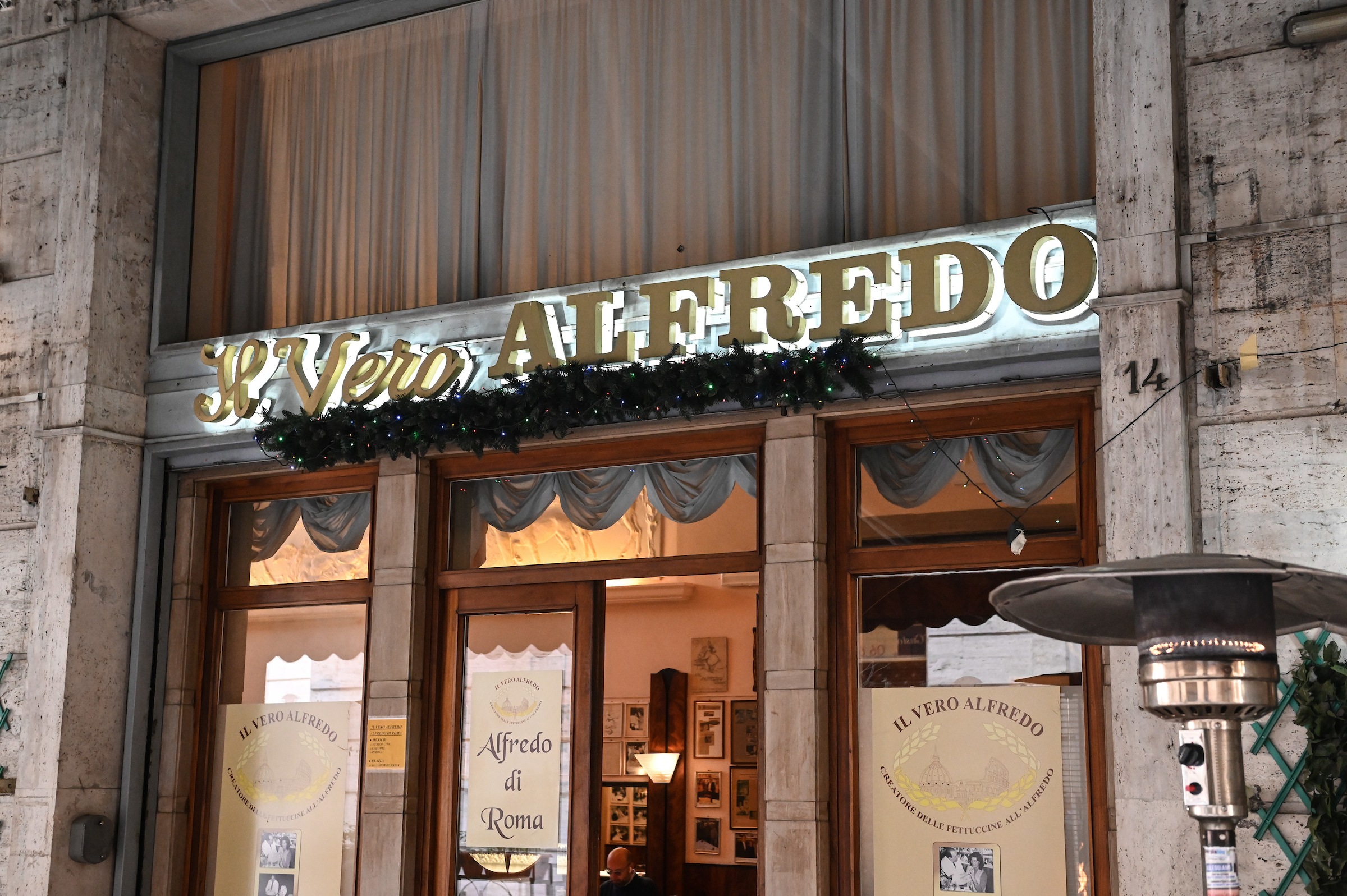
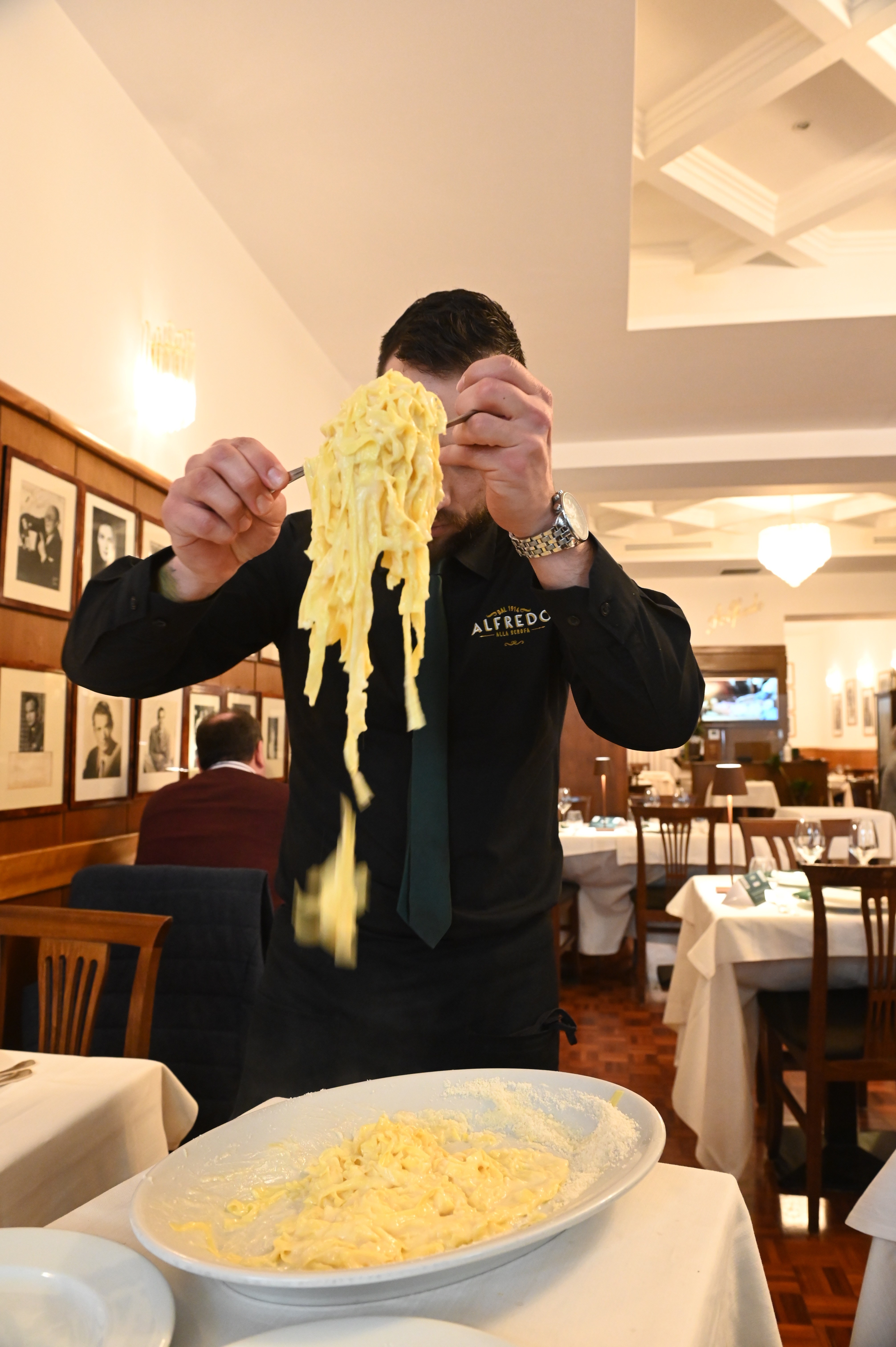
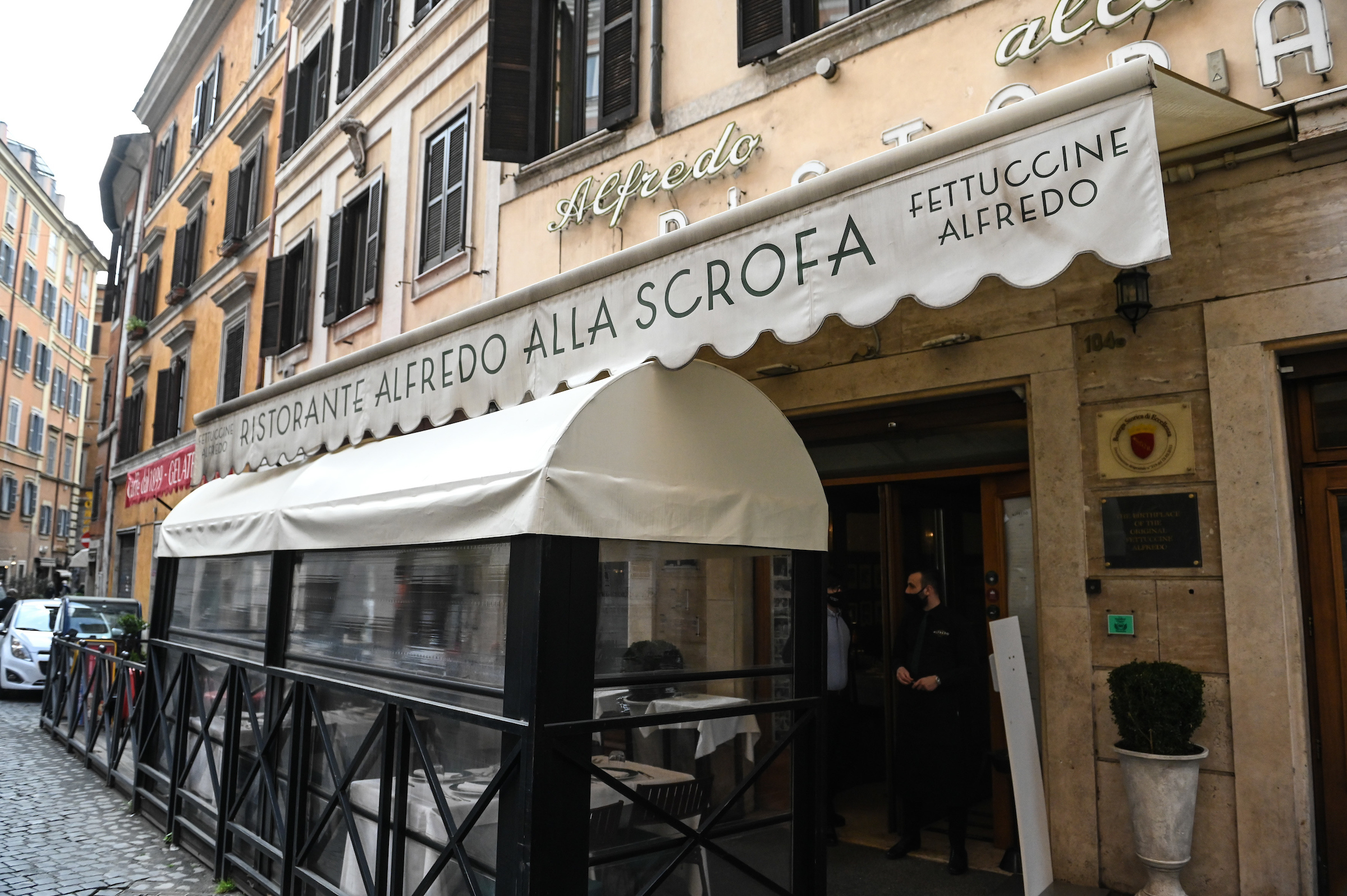
“It’s a real gesture of love, moving the fettuccine with one fork and one spoon, making this normal pasta into this very special sauce,” says Mario Mozzetti. “We are selling pasta in its simplest form.”
Il Vero Alfredo
But di lelio’s story wasn’t finished. In 1950, the war safely behind him, he returned to Rome and opened a new restaurant, Il Vero Alfredo, or the True Alfredo, just a few minutes away from the original. More walls plastered with more headshots, now Ella Fitzgerald and Ernest Borgnine, Jean-Paul Sartre and Walt Disney.
Today, it is run by his granddaughter and great-granddaughter, Ines di Lelio and Chiara Cuomo. The recipe is almost identical, with interesting differences. The fettuccine isn’t nearly so thin, giving the finished dish a pleasant chew. The cheese is younger, aged just 16 months. And there is less of it. The butter, too.
Assembly is the same, tableside again, this time using a golden spoon and fork set gifted and engraved by Fairbanks and Pickford in 1927. Though the fettuccine itself is heavier, the finished dish is ever-so-slightly lighter than the version served on Via della Scrofa, a change that unexpectedly gives the savory-creamy cheese more—not less—presence.
And yet, it still is torridly heavy. Mind you, both versions are wonderful, sinfully so. But I start to understand why Italians dismiss the dish. Despite its simplicity, I’d never make this at home, an indelible, weighty tangle of fat and starch. But the recipe’s ancient lineage intrigues me. So I ask Ines and Chiara about that, and they mention names I’ve never heard.
Pasta in bianco. Burro e Parmigiano. Pasta pancia sconvolta.
Fettuccine Alfredo, it seems, has many names. And the last translation makes me laugh. White pasta. Butter and Parmesan. Upset belly pasta. That ancient Roman macaroni, it turns out, evolved into the chicken soup of Italy, into the dish Italians make—particularly for children—when they feel sick.
“When people used to come here, my grandfather was asked, ‘What’s your specialty?’ He’d say, ‘Fettuccine with Parmigiano and butter,’” Ines said. They always responded the same. “But we’re not ill!”
Assembly is the same, tableside again, this time using a golden spoon and fork set gifted and engraved by Fairbanks and Pickford in 1927. Though the fettuccine itself is heavier, the finished dish is ever-so-slightly lighter than the version served on Via della Scrofa, a change that unexpectedly gives the savory-creamy cheese more—not less—presence.
And yet, it still is torridly heavy. Mind you, both versions are wonderful, sinfully so. But I start to understand why Italians dismiss the dish. Despite its simplicity, I’d never make this at home, an indelible, weighty tangle of fat and starch. But the recipe’s ancient lineage intrigues me. So I ask Ines and Chiara about that, and they mention names I’ve never heard.
Pasta in bianco. Burro e Parmigiano. Pasta pancia sconvolta.
Fettuccine Alfredo, it seems, has many names. And the last translation makes me laugh. White pasta. Butter and Parmesan. Upset belly pasta. That ancient Roman macaroni, it turns out, evolved into the chicken soup of Italy, into the dish Italians make—particularly for children—when they feel sick.
“When people used to come here, my grandfather was asked, ‘What’s your specialty?’ He’d say, ‘Fettuccine with Parmigiano and butter,’” Ines said. They always responded the same. “But we’re not ill!”
Caseificio Ugolotti
Armed with this deeper understanding— and confident no upset belly could handle a pasta pancia sconvolta as heavy as the Alfredos I’d tasted in Rome—I went in search of a lighter version. Il Vero Alfredo had demonstrated that with the cheese, less was more. I needed to understand this. So I headed north to Parma, home of Parmigiano-Reggiano.
Caseificio Ugolotti wasn’t the idyllic dairy I was expecting. A modern warehouse wedged next to a McDonald’s on a busy road on the outskirts of town, it nonetheless maintains the ageold Italian tradition that the master cheesemaker gets a house onsite as part of his compensation. For good reason. “They are like children,” Attilio Buccella says of his cheese. “You care for them from the morning you make them until the day they are sold.”
His lesson? With Parmigiano-Reggiano, a lot becomes a little, and a little goes a long way.
Parmigiano-Reggiano, which can be made only in Italy’s Parma region, consists of just three ingredients: cow’s milk, rennet and salt.
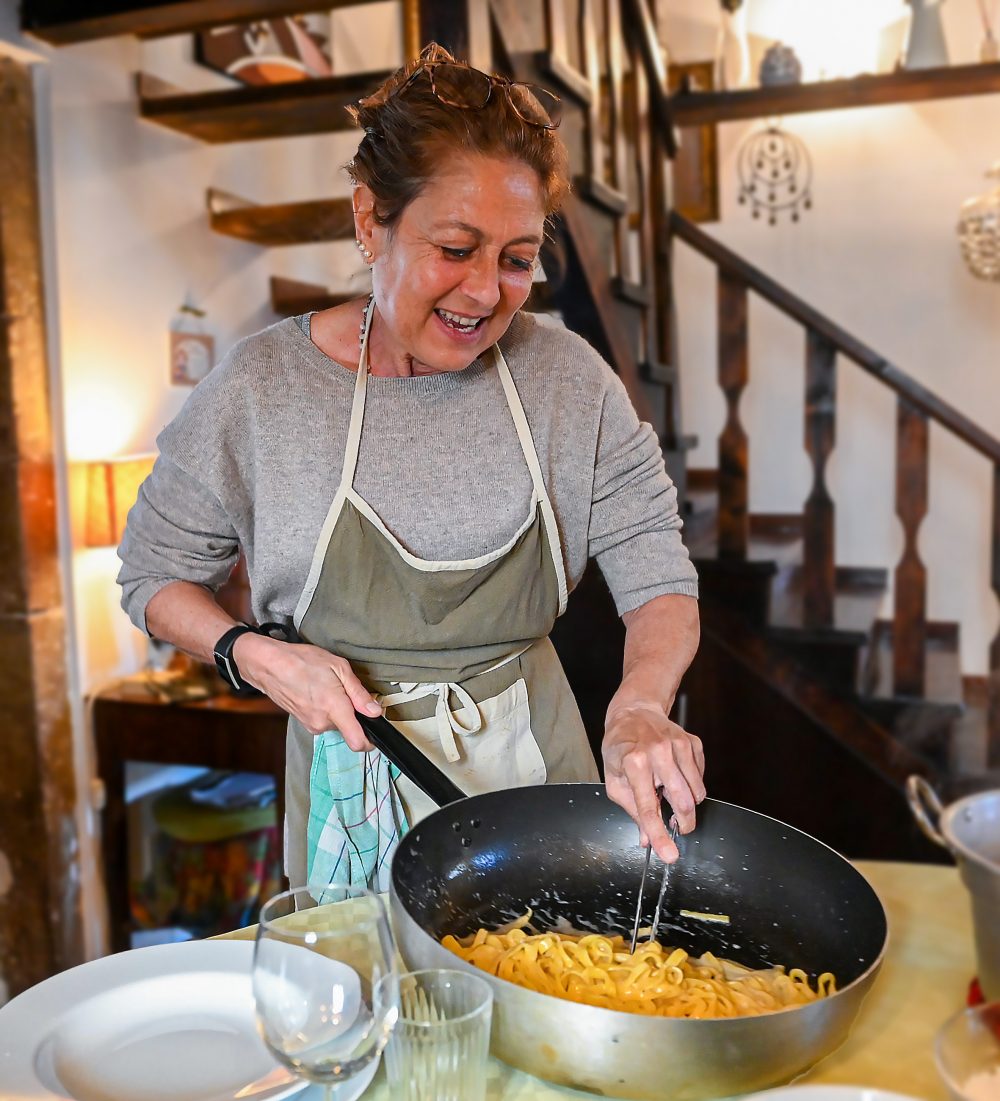
A simplicity that belies the complex process during which 1,200 liters of fresh milk are reduced to two 50-kilogram wheels of fresh cheese. Brined and aged for many months, those wheels lose at least another 5 kilograms, a reductive process that creates a cheese of intense complexity.
Caseificio Ugolotti’s seemingly unromantic locale transforms the instant I step into the warehouse, two stories tall and stacked with nearly 12,000 massive wheels of Parmigiano- Reggiano from floor to ceiling. The smell is sensual, a wave of umami that washes over you, never breaking. We taste the cheese fresh, and aged 12 months, 24 months and 36 months. Powerful doesn’t capture it. This isn’t Parmesan. This is Parmigiano-Reggiano. Potently so.
Shove too much in your mouth—and the temptation is high—and you lose it, an onslaught of flavor through which you can appreciate nothing. Let just a bit melt on your tongue, transform into the essence of savory in your mouth, now that you can appreciate. I was starting to understand why the Alfredos in Rome had left me wanting.
Castelnuovo di Porto
Just 30 minutes north of Rome, in a tiny hilltop village—Castelnuovo di Porto—the threads come together. Here, in a town of winding cobblestone roads and homes that cling precariously to the walls of a medieval castle, I meet Francesca Guccione, a home cook who learned her recipes from her mother and grandmother.
She doesn’t know fettuccine Alfredo, but she certainly knows pasta in bianco. And her recipe, masterfully, synthesizes everything I’d been trying to understand. Guccione has been cooking since she was 9, and her kitchen spills into the rest of the house, cutting boards and other kitchen tools stacked on white plaster windowsills above a terracotta floor.
She cooks by instinct, and her instincts are spot on as she walks me through her pasta in bianco. The pasta—thick, eggy fettuccine—is cooked in barely enough water, producing a super-starched, almost white cooking water that is as important an ingredient to the finished dish as are the cheese and butter. For it is that starch that will bind them smoothly.
The creaminess of the sauce, she explains, isn’t from the cheese and butter. They are key, of course, but too often cooks lean too heavily on them. “The trick is to use less butter and less cheese and more cooking water to get a creamy, but light sauce,” she explains as she adds to a barely warm skillet just a tiny fraction of the butter I’d seen elsewhere.
When the pasta is not quite al dente, she forks it out into the skillet with the now softened, slightly melted butter. That starchy cooking water splashes along with the noodles into the pan. But that’s not enough; she adds another two ladlefuls. And then she tosses. And tosses. And tosses. Minutes go by, those starches and butter and noodles bonding.
Only at this point, when the sauce already looks creamy, does she add spare sprinkles of Parmigiano-Reggiano, a bit at a time, punctuated with more tossing and more tossing and more tossing.
The result is magical and balanced. Creamy and coated and rich, but not thick or heavy. Luscious, not overwrought. I can taste every ingredient, the butter, the pasta, the cheese. It’s a cooperative, not a domination.
“Che bello!” Guccione pronounces. I agree wholeheartedly.
